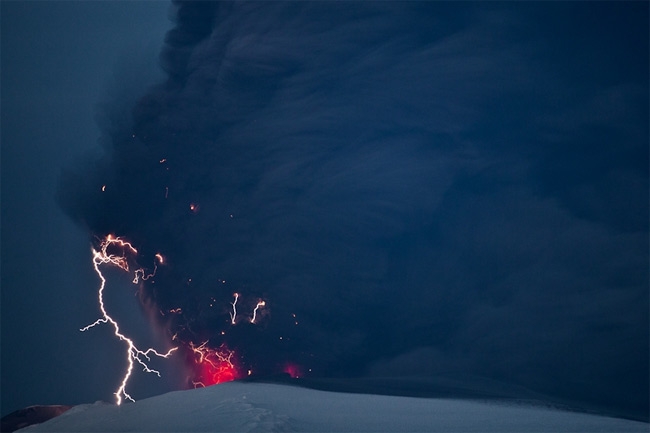Volcanic Lightning Can Help Track Ash Plumes

Lightning could be used to estimate the height of an ash plume spewed by an erupting volcano, new research suggests.
The eruption of the Icelandic volcano Eyjafjallajökull in April created a giant ash cloud, which at one point covered most of Europe, created fiery red sunsets , and brought international aviation to a temporary standstill, resulting in travel chaos for tens of thousands.
While volcano researchers can use satellites and radar to track the progress of a plume, they often have a hard time keeping an eye on the billowing ash as night falls and the weather changes. The lightning that accompanies these plumes may help this effort.
The new research suggests that the big lightning strikes in the Iceland plumes' upper reaches correlated with the plumes' heights, which is consistent with other recent work.
Volcanic lightning
Eyjafjallajökull first began pumping volcanic ash into the atmosphere on March 20. Within days, the ash plume cloud reached a height of 5.6 miles (9 kilometers). The plume was so electrically charged that it made its own lightning, which could be detected many thousands of miles away, in both day and night, and during other weather, according to the study, which was based on measurements from the lightning location network (ATDnet) at the U.K. Met Office.
"There's the idea that volcanic eruptions are dirty thunderstorms," said Earle Williams, an atmospheric scientist at MIT, who was not involved in the new research but has studied the relationship between cloud height and lightning flashes.
Sign up for the Live Science daily newsletter now
Get the world’s most fascinating discoveries delivered straight to your inbox.
How this concept works exactly is unclear, but ash particles can become coated in ice after they reach about 3.1 miles (5 km) tall. These ice particles would behave like particles in a thunderstorm: As they collide and pull apart, a charge builds up and big lightning can strike.
Another possibility is that the water in the volcano's magma could be freezing and creating lightning by the same mechanism, Williams told OurAmazingPlanet. But researchers need to know more about the properties of the ash plumes before settling the issue.
Either way, the correlation with plume height and lightning frequency works like this: the higher the plume, the colder the top of the plume, the more ice and, therefore, the more lightning.
Airplane alert
But estimating the height of plumes satisfies more than mere academic curiosity. "From a practical standpoint, the aviation industry is extremely concerned about volcanic eruptions," Williams said. "Airplanes don't even want to go in an ordinary thunderstorm, but this is worse."
Ash plumes have more ice and rocks and can foul any airplane unlucky enough to fly through them. There have been instances where 747 jets have lost all four engines after flying through an ash plume, Williams said. If air traffic controllers had a more accurate estimate of how these plumes were growing, they would have a better idea how to avoid them.
The study was published in the Dec. 10 edition of the journal Environmental Research Letters.









